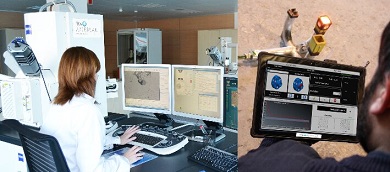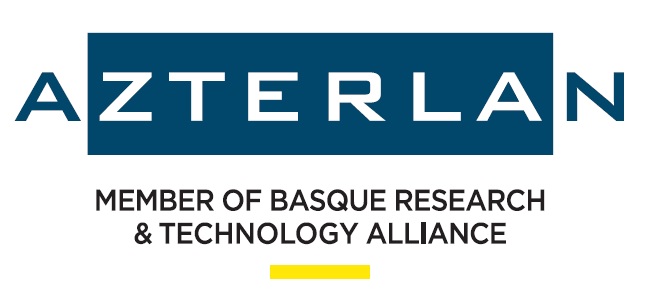NAME Egoera likido eta solidoko metalen karakterizazio metalurgiko sistema aurreratuak planta pilotuetan edo lantegi industrialetan

Azterlanek ekipamendu zabala du galdaketaz fabrikatutako edo forjatuz, estanpazioz, fabrikazio gehigarriz eta abarretatik eraldatutako osagai metaliko likido eta solidoen eta proba-piezen kalitatea ezaugarritzeko. Likidoak karakterizatzeko ekipoak eramangarriak dira, beraz, kontrolak Azterlan edo bezeroaren instalazioetan egin daitezke. Mikroegiturak (faseak, porositatea, inklusioak) eta propietateak alderatuz, prozesuko parametro optimoak identifikatu daitezke haien errendimendua hobetzeko.
FIELDS OF APPLICATION
Coatings and Surfaces solutions
Design and development of materials
MOST OUTSTANDING EQUIPMENT AND COMPONENTS
-
Advanced Corrosion Laboratory
Potentiostats/Galvanostats: Autolab PGSTAT302N and a FRA32M module for impedance. Autolab PGSTAT101 (portable). Hydrogen permeation: Two PGSTAT302F potentiostats. Surface quality control instruments: Mobile Surface Analyzer MSA (KRUSS) and CleanSpector (SITA) for fluorescence inspection. Technical resources for stress testing in natural atmospheres or H₂S-type environments. Methods for applying stress include constant strain (multi-point bending tests) or constant load. Corrosion chambers for salt spray and condensed vapor atmospheres. Combined cycle chambers.
-
Linseis quenching dilatometer (L78) and thermobalance
Equipment for evaluating dimensional changes in metal samples during heating and/or cooling at various rates. Helium is used for high-speed testing. The dilatometer enables the development of CCT and TTT diagrams and determines the minimum cooling rate to avoid forming specific phases.
-
Liquid metal quality analysis equipment
Azterlan has proprietary analysis tools: Thermolan®, Thermolan-Al, Alu-Q, density at 80 mbar, micro and macroinclusion tests. Test sample molds for evaluating mechanical properties, castability, inclusions, feeding capacity, etc. Also includes commercial equipment for O₂ and H₂ measurement in steels, thermal cameras, pyrometers, etc.
-
Optical microscopy, Field Emission Scanning Electron Microscopy (FEG-SEM), EBSD
Stereomicroscopes and optical microscopes are equipped with image analysis systems. An optical microscope with a heating stage allows thermal cycling of the sample under study. The FEG-SEM is equipped with energy-dispersive X-ray detectors (EDS), wavelength-dispersive spectroscopy (WDS), and electron backscatter diffraction (EBSD).
-
Solid-state characterization tests: chemical, mechanical, magnetic, residual stress (hole drilling), non-destructive, etc.
Chemical analysis, hardness tests, three-axis fatigue bench, Small Punch tests, pull-out tests, residual stress evaluation by hole drilling, magnetometer with multiple sensors, and computed tomography tests with capabilities for surface and defect reconstruction, Airpointer equipment for real-time monitoring of pollutant gases such as NOx, CO, SO₂, O₃, and volatile organic compounds (VOCs), Grimm 365 equipment for measuring particulate matter PM₁₀, PM₂.₅, and PM₁, etc.
SERVICES OFFERED BY THE ASSET
Defect characterization: identification of possible causes and proposal of solutions
Defect analysis service focused on identifying causes and proposing solutions through fracture surface and cross-sectional microstructure analysis. Techniques include stereoscopy, optical and SEM microscopy, EDX and/or WDX spectroscopy to detect and characterize defects with high accuracy.
Environmental, fatigue, intergranular, and pitting corrosion tests
Neutral Salt Spray Tests. Condensed Vapor Tests. Cyclic Corrosion Tests. Fatigue tests with cathodic protection. Intergranular corrosion tests. Pitting corrosion tests.
Environmental, fatigue, intergranular, and pitting corrosion tests:
Neutral Salt Spray Tests. Condensed Vapor Tests. Cyclic Corrosion Tests. Fatigue tests with cathodic protection. Intergranular corrosion tests.
Liquid metal (melt) characterization
Evaluation of key parameters: metal temperature, dissolved gas content, presence of inclusions (macro and micro). Castability and feeding capability tests. Quality characterization via thermal analysis. Thermal imaging to detect temperature and pouring stream anomalies, etc.
Metal characterization: microstructure and properties
Phase analysis: morphology and chemical distribution via Backscattered Electrons (BSE). Analytical profiles and element distribution maps via EDX and/or WDX. EBSD crystallographic maps. Mold thermal mapping. Complemented with static, dynamic, magnetic, and residual stress property evaluation. Gas emissions and particulates monitoring.
ENTITY MANAGING THE ASSET

Contact person:
Susana Méndez
smendez@azterlan.es